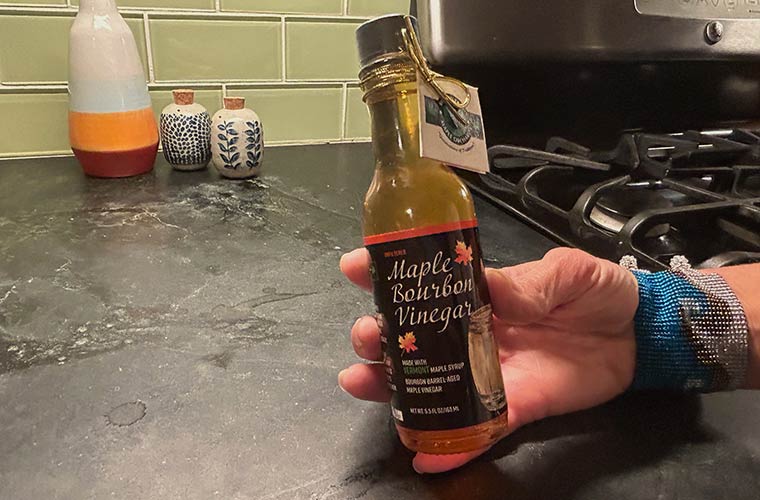A Sweet Partnership As the calendar turned to 2025 and we finished our end-of-year paperwork,…

Farm Family Gambles it can Switch to Maple
A visitor to the Branon Family’s sugarhouse in Fairfield in Franklin County is offered a seat in a handcrafted pine chair at a butternut table, and is handed a mug of coffee flavored with two popular Vermont products: milk and maple syrup.
The furniture and milk are about the only things that don’t scream maple at Branon Family Maple Orchards.
It’s the last week of February, nearly the start of sugaring season, and Cecilia Branon, 54, is a buoyant host, serving the hot beverage on a cold day and explaining how the Branons’ maple operation has grown so much over the years.
Not surprisingly, she begins with the weather, always of concern. It’s been cooperating lately. Two feet of snow rest across Fairfield thanks to a weekend storm. And in next-door Bakersfield, in a natural bowl called ‘Cold Hollow,’ where the family has some 1,000 acres, the snow is waisthigh to a tall adult.
Snow, Cecile notes, keeps things cooler, prolonging the season in their little snowbelt, givng them a few more days of sugaring when the rest of the state is hit by too-warm temperatures. It also will quench the thirst of the maples, which have been looking a little dry lately.
Cecile’s husband Tom is in the woods tapping trees with his work crews, but she and their college-age son Evan have taken time to relate how sap at the Branon farm is collected, stored, boiled into syrup, and how some of it goes into specialty products, from candy to maple cream to barbecue sauce.
Some they sell at the farm, but lots goes to restaurants, food coops and granola makers. Most is trucked in bulk to the Butternut Mountain Farm in Morrisville, a major distributor to points across the U.S.
The anteroom with the butternut table is bedecked with evidence of hard work and maple mastery— blue ribbons from Franklin County Field Days; framed citations and expressions of gratitude for volunteer work in the Vermont maple community; and snapshots chronicling the family’s sugaring exploits over the decades.
The photos go back almost to the time Cecile, a St. Albans teenager, met Tom, developed a crush, and began working with him on the farm. She milked and hayed and pushed manure, doing tasks, she says, with a laugh, that women usually didn’t do.
In spring she and Tom, with horses, brought sap from tree to sugarhouse. And wouldn’t you know, they eventually married, and began having sons, four of them.
Bought The Farm
In 1984, with the purchase of the dairy farm from Tom’s parents, the couple became the fifth generation of Branons to work the land. At the height of their dairying operation, they were milking 100 cows yearround, says Cecile.
Yet things eventually turned sour due to events beyond their control. And then they turned sweeter.
In the early 2000s, like other Vermont farmers, they began struggling with low milk prices, which were about the same level in 2004 as they were in 1984. Tom and Cecile faced another challenge: their buildings and milking equipment needed upgrading, but to upgrade, they would need to milk more cows, and to milk more cows they would need more cropland.
“We were burned out,” says Cecile. They saw the vicious circle, and got out of dairying.
“The hardest day of my life was the day the cows left, May 17, 2004,” says Tom, chatting later by phone after a day in the woods. “When you’ve been dairying all your life, change looks scary.”
The Branons had always tapped maple trees, plenty of them, but they had always considered it a form of diversification, a way to help even things out, to compensate for the ups and downs of dairying.
But what they did after the cows were sold was virtually unprecedented in Vermont. They went full bore into sugaring. Instead of buying more cropland, they bought more forestland. “Tom and I were pretty determined,” says Cecile.
They now have 75,000 taps across some 2,400 acres – numbers that would have been unheard of several years ago.
Tops In The State?
“There are probably four or five sugar-makers who have 50,000 or 60,000 taps, but Tom’s taps are probably the most,” says Henry Marckres, the state’s maple-sugar specialist.
“To be that big takes a tremendous amount of land and trees, and it requires a huge expense,” says Marckres. “Lots of people don’t want that risk.”
The Branon operation would disappoint a nostalgia seeker. No wood smoke curling up from the sugarhouse; no buckets on trees, water dripping sonorously; no old Vermont Life scene of horses pulling sleds across snow.
But, boy, is it efficient. Theirs is a high-tech operation with a spotless sugarhouse with, after all, an anteroom of handsome pine chairs and butternut table. Not to mention the adjoining rooms with the oil-fired evaporator; vacuum pumps; miles of plastic tubing; dozens of 55-gallon barrels into which syrup will soon be poured; reverse-osmosis equipment; ATVs for driving along forest trails, and, out back, a tanker truck, two 22,000-gallon sap-holding tanks and a 16,000-gallon water tank to hold water recaptured during the evaporation process.
Hear that whooshing sound? That’s water from that water tank running through and cleaning copper pipes.
Because of the Branon’s efforts, and that of fellow sugar-makers in the area, Franklin County is considered the state’s top-producing county in the state that produces – 1.4 million gallons last year – the most syrup in the nation.
Statewide Increase
Marckres, the syrup specialist, guesses that Vermonters put up some three million taps each season, a number that’s been rising significantly, thanks, in part, to steady market demand.
Like all farmers, though, the Branons understand their crop is vulnerable to natural forces (such as the unusually warm temperatures that have hit Vermont the past two weeks). Scientists say the amount of calcium in the soil is diminishing in some areas, affecting tree health. Climate change is a worry.
Looking out the window at the snow, much higher on this February day than in other parts of the state, Evan says he’s not too worried about global warming, but he doesn’t appreciate the toll taken by ice and powerful winds that some believe is another manifestation of climate change. He does worry about the maple-tree-killing Asian long-horned beetle that’s turned up as close as Massachusetts.
In late 2010 a windstorm combined with heavy snow to knock down 6,000 trees on the Branon Farm, “Then we had wind on the second weekend of April last year that knocked down another 1,000 trees,” says Cecile.
The Branons anticipated difficulties, and show no regrets about leaving dairy farming.
“Their choice was to ‘man-up’ and go ahead with sugaring, or become nine-to-fivers,” says Evan of his parents.
“When they sold the cows, they took a huge, huge chance, and now they are kind of ahead in the ballgame.”
(A postscript: Cecile reported Thursday (March 15) that the Branons have only about one-third of their expected crop of maple syrup, but there were still several inches of snow in Fairfield and a good two feet in Bakersfield. She said temperatures on her farm have been about 10 degrees colder than in central and southern Vermont, but with the forecasts of warm temperatures for the rest of March, “We have to take it day-to-day.” She added: “Our higher elevations in the north may be our saving grace.”)
Originally published on The Herald.























